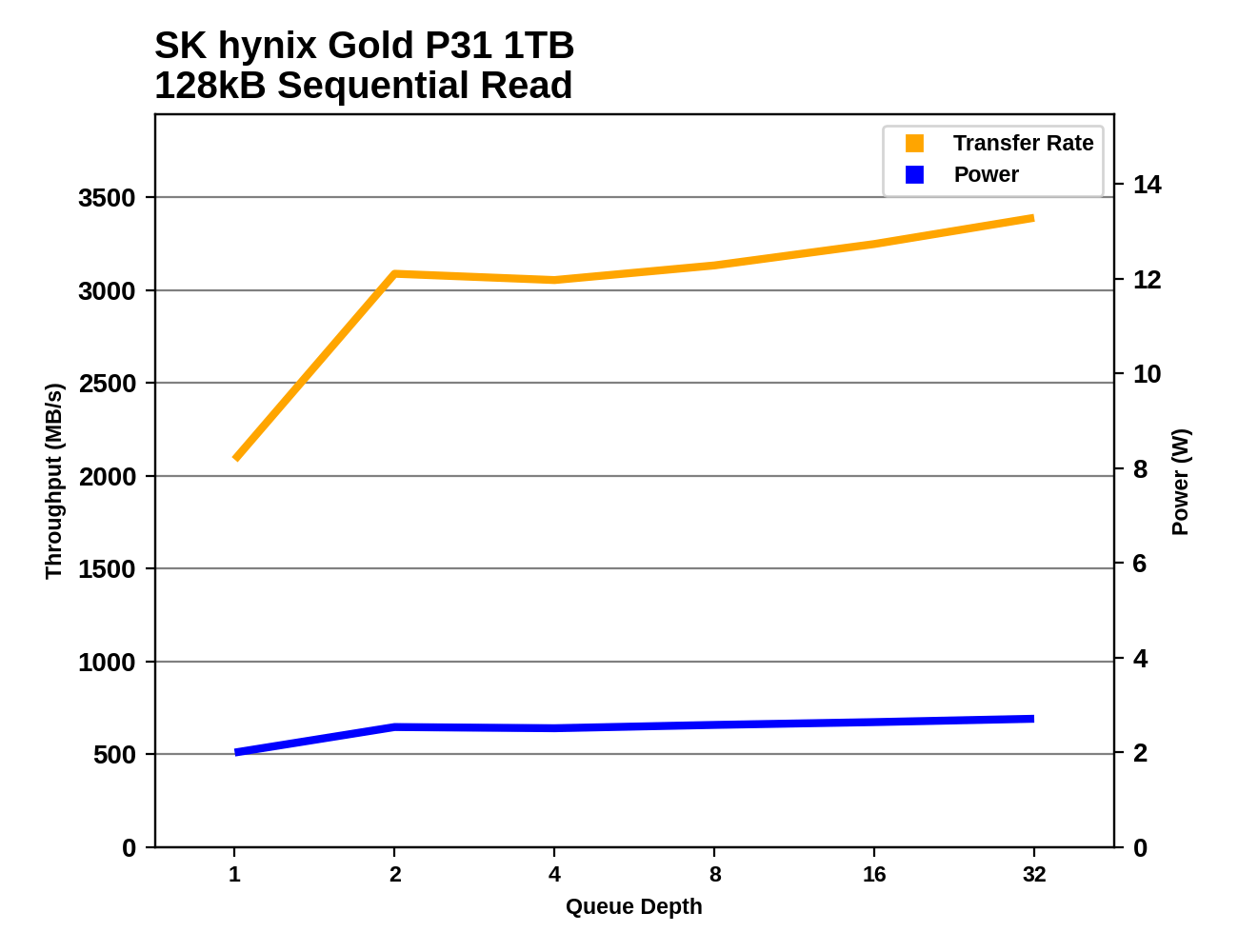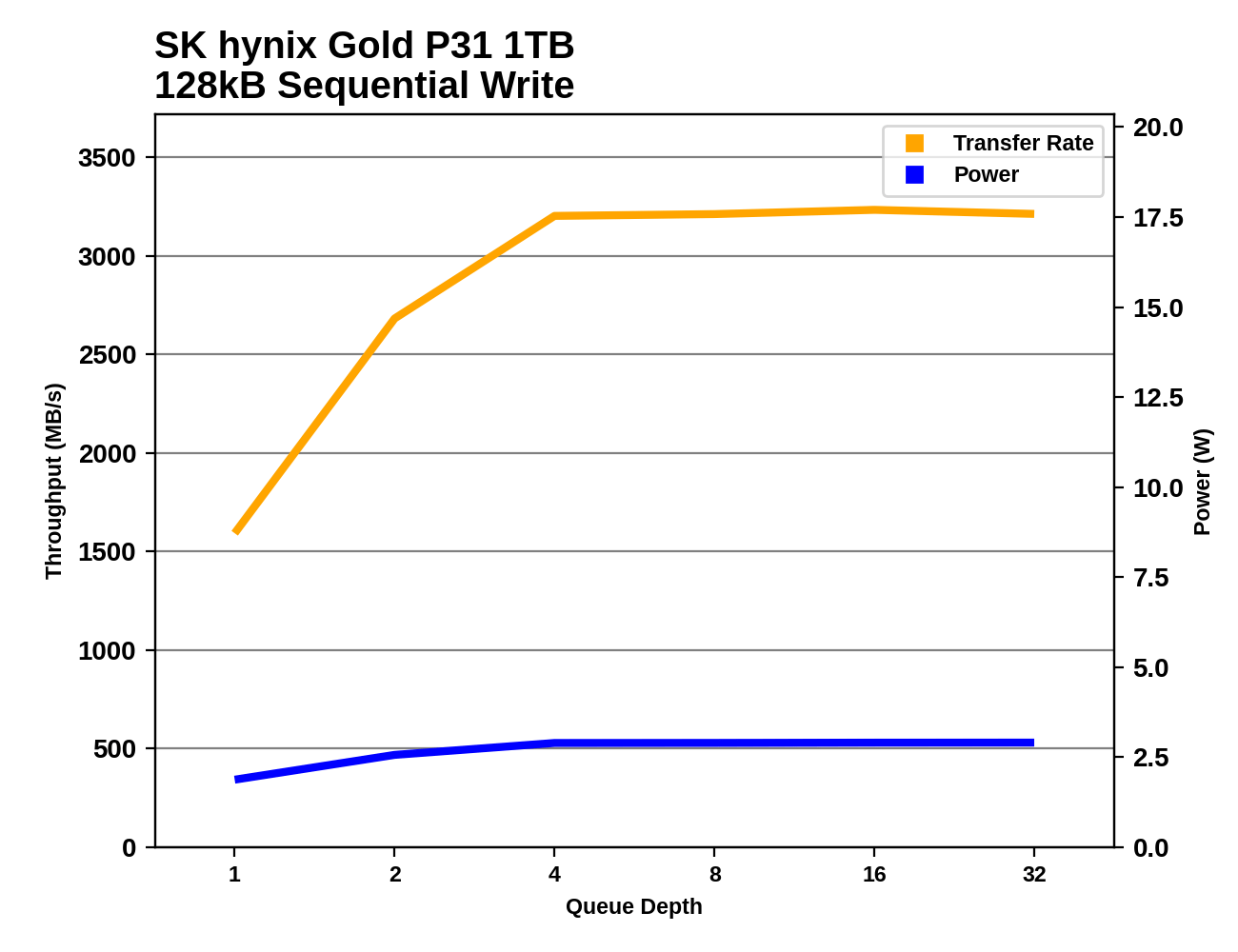The Best NVMe SSD for Laptops and Notebooks: SK hynix Gold P31 1TB SSD Reviewed
by Billy Tallis on August 27, 2020 8:00 AM ESTSequential Read Performance
Our first test of sequential read performance uses short bursts of 128MB, issued as 128kB operations with no queuing. The test averages performance across eight bursts for a total of 1GB of data transferred from a drive containing 16GB of data. Between each burst the drive is given enough idle time to keep the overall duty cycle at 20%.

The burst sequential read performance from the SK hynix Gold P31 is very good, but not quite fast enough to beat the drives based on the Silicon Motion SM2262EN controller.
Our test of sustained sequential reads uses queue depths from 1 to 32, with the performance and power scores computed as the average of QD1, QD2 and QD4. Each queue depth is tested for up to one minute or 32GB transferred, from a drive containing 64GB of data. This test is run twice: once with the drive prepared by sequentially writing the test data, and again after the random write test has mixed things up, causing fragmentation inside the SSD that isn't visible to the OS. These two scores represent the two extremes of how the drive would perform under real-world usage, where wear leveling and modifications to some existing data will create some internal fragmentation that degrades performance, but usually not to the extent shown here.

On the longer sequential read test that involves some slightly higher queue depths, the Gold P31 is basically tied for first place when reading data that was written sequentially. When reading data that has previously been fragmented by the random write test, the P31's performance is considerably higher than the other flash-based SSDs and closer to the Optane 905P.
 |
|||||||||
| Power Efficiency in MB/s/W | Average Power in W | ||||||||
In absolute terms, the power consumption of the Gold P31 isn't drastically lower than some of the other fairly efficient high-end NVMe drives like the WD Black SN750. But once performance is taken into account, the Gold P31's efficiency stands far above the competition.
 |
|||||||||
The SK hynix Gold P31 doesn't need high queue depths to deliver good sequential read throughput: at QD2 it's already above 3 GB/s, but there are further slight performance increases from higher queue depths. That performance profile is very similar to the Samsung 970 EVO Plus, but that drive requires about twice the power that the P31 uses.
Even at QD1, the sequential read performance from the Gold P31 is above the ~2GB/s limit of most other four-channel NVMe drives we've tested (with eg. Silicon Motion SM2263 based controllers). That leaves it entirely in a performance range where all the competitors are 8-channel drives that don't come close to matching power efficiency of the Gold P31.
Sequential Write Performance
Our test of sequential write burst performance is structured identically to the sequential read burst performance test save for the direction of the data transfer. Each burst writes 128MB as 128kB operations issued at QD1, for a total of 1GB of data written to a drive containing 16GB of data.

The SK hynix Gold P31 has fairly ordinary burst sequential write performance by high-end NVMe standards: tied with the SM2262EN-based ATATA SX8200 Pro but beat by the Phison-based Seagate drives.
Our test of sustained sequential writes is structured identically to our sustained sequential read test, save for the direction of the data transfers. Queue depths range from 1 to 32 and each queue depth is tested for up to one minute or 32GB, followed by up to one minute of idle time for the drive to cool off and perform garbage collection. The test is confined to a 64GB span of the drive.

On the longer sequential write test that brings in higher queue depths, the Gold P31 is tied for second place, while the Phison E16 based Seagate drive (built for PCIe 4 speeds, but limited by this testbed to PCIe 3 speeds) unsurprisingly takes first place.
 |
|||||||||
| Power Efficiency in MB/s/W | Average Power in W | ||||||||
At this point, the record-shattering power efficiency scores from the SK hynix Gold P31 are no longer a surprise. The overall fastest drive has the second best efficiency score (56% the performance per Watt of the P31) and the next two most efficient drives are much slower NVMe drives from Toshiba/Kioxia.
 |
|||||||||
The Gold P31 doesn't reach its full sequential write speed until QD4, while several of its competitors saturate at QD2. However, once the P31 is at full speed, it has one of the best sustained write speeds, and shows no sign of its SLC cache running out at any point during the test. Power consumption is comparable to the slowest NVMe drive that can barely hit half the throughput of the Gold P31.
Similar to the sequential read results, the P31 starts out at QD1 with high performance that almost puts it beyond what other 4-channel NVMe drives can do at any queue depth. From there, the P31 continues to redefine what's possible with an increasingly wide lead in power consumption relative to all other high-end drives we've tested.












80 Comments
View All Comments
MrCommunistGen - Thursday, August 27, 2020 - link
Truly impressive drive! I'm glad you were able to confirm that the power efficiency numbers held up and weren't the result of some kind of measurement error. When the Platinum P31 comes out I'll probably snag a 2TB model to upgrade my 1TB XG6 in my main ITX rig.Interesting that you mentioned the SN520. I needed a 2242 or 2230 SSD for a project I'm working on and was trying to decide between a BG4 and the SN520. I was able to refer to the previous Anandtech 1TB BG4 review but even then, I'm looking at either a 128GB or 256GB drive as that's what's available 2nd hand on eBay and the 1TB drive's performance isn't going to really represent the smaller drives.
On the other hand I've found exactly nothing on the SN520.
They're cheap enough so I decided to just buy one of each and test them both and see how they compare.
Luminar - Thursday, August 27, 2020 - link
The 2280 form factor SN500s/SN520s are more common than the 2242s and 2230s.I would buy a 2280 SN520 and just Dremel it down to a 2242 form factor. It's been proven to work. As Anandtech wrote in their review, the electronics are only in the first 30mm of the PCB.
MrCommunistGen - Thursday, August 27, 2020 - link
For the heck of it I decided to buy a bunch of different 2230 and 2242 SSDs on eBay to test. I was surprised to find 6 different models, 5 of which are from well-known brands. They all seem to be OEM drives pulled from laptops.I skipped any of the no-name, known garbage drives.
lilkwarrior - Thursday, August 27, 2020 - link
Why was the 970 plus in the benchmarks, but not the 970 Pro?MrCommunistGen - Thursday, August 27, 2020 - link
If you really want to compare the performance of the P31 and the 970 Pro, you can look up the results in the "Bench" section of the website:https://www.anandtech.com/bench/product/2627?vs=24...
To answer your question directly:
I'd imagine that's because for a lot of client workloads the performance of the 970 Pro is relatively similar to the 970 EVO Plus. The Pro definitely has lower latency, particularly write latency -- but again -- in most client workloads that isn't going to translate into very noticeable differences.
However, the Pro is SO much more expensive. Realistically, someone shopping for a fast consumer SSD who is looking at the P31 isn't going to also be considering the 970 Pro.
FWIW, at the 1TB capacity the 970 Pro seems to be selling for ~$320, the 970 EVO Plus for ~$190, and the P31 for $135.
If the idea is to compare to the highest performing non-volatile storage available today, that's probably what the Optane 905P results are for.
PaulHoule - Thursday, August 27, 2020 - link
It is as if Taiyo Yuden started making writable DVD's under its own name.nirolf - Friday, August 28, 2020 - link
Ha ha! Good one!jyotaro - Thursday, August 27, 2020 - link
Any plans for a 500gb review of this product?Billy Tallis - Thursday, August 27, 2020 - link
Not at the moment. I'll try to get them to cough up a sample of that one when the Platinum P31 is released so I can compare across the full range of capacities, but I don't know how likely it is that they'll agree. This is still a pretty new relationship between us and SK hynix PR.ozzuneoj86 - Thursday, August 27, 2020 - link
Maybe I missed it, but does the high efficiency of this drive translate to significantly less heat output? Seems like it should. Some kind of thermal test would be useful for choosing a mobile SSD especially.